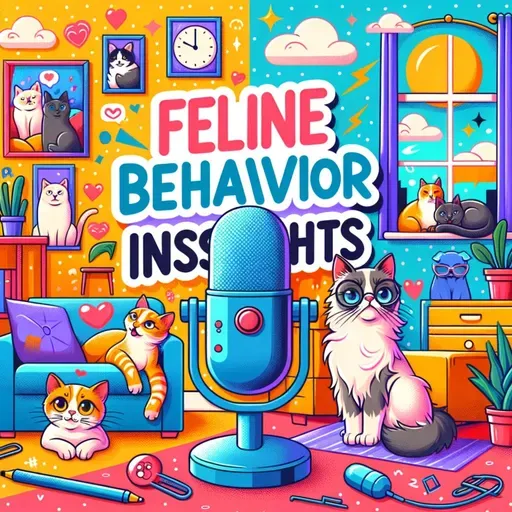
24 September 2025
"Unlock the Language of Feline Behavior: Purrs, Kneads, and Beyond"
Feline Behavior Insights
About
Welcome to Feline Behavior Insights. Cats may seem mysterious, but their behaviors speak volumes about their needs, moods, and personalities. Unlike dogs, cats have a reputation for independence and subtlety, but every action, from a gentle purr to a quick flick of the tail, has meaning.
According to Dr. Chris Roth, purring, grooming, kneading, and climbing are among the most common cat behaviors. Purring is generally a sign of contentment, although cats may also purr when stressed as a form of self-soothing. Grooming not only keeps a cat’s fur clean; it is also a calming and social activity. When cats knead with their paws or "make biscuits," it’s a comforting motion that kittens do while nursing, and adults retain this habit when they feel especially relaxed. Climbing and perching satisfy a cat’s need to observe their environment while feeling secure.
Paying attention to a cat’s body language opens up even more communication. According to Best Friends Animal Society, a relaxed cat has loose, fluid movements. You might notice them loafing with their paws tucked underneath or stretching out. When cats love you or another feline, they may circle around your legs, head-butt you, or rub their cheeks on your body. These actions mark you as a friend using scent glands on their heads.
PetMD explains that a confident and happy cat will walk with their tail straight up, sometimes with a little curl at the tip. If a cat slowly blinks at you, blink back—it’s the feline version of a warm hug, signaling deep trust. When they show their belly, it signals comfort and trust but isn’t necessarily an invitation for a tummy rub. Playful cats crouch, wiggle, and pounce—these behaviors are rooted in their instinct as hunters.
Stress in cats shows through a tense, low-to-the-ground posture, ears turned sideways or back, and a tail pulled close or flicking. According to the team at Tuft & Paw, a tucked tail means a cat feels threatened, while a puffed-up tail makes them look bigger in defense. Aggression is often a panic response, not malice; wide eyes, flattened ears, and an arched back mean a cat feels cornered and might lash out.
Natural scratching is another important behavior, as described by Pets Best Insurance. Scratching maintains healthy claws and marks territory. Providing scratching posts helps direct this instinct productively.
Cats, curious by nature, may push objects off shelves or seemingly interfere with our daily lives purely out of playful exploration. Understanding your cat’s regular habits is essential, since sudden changes in behavior might signal health issues.
Recognizing and respecting feline behavior helps strengthen the human-cat bond. Every tail flick, meow, and nuzzle is a unique message from your cat. Pay attention and you’ll discover a new depth to your relationship.
Thanks for tuning in and don’t forget to subscribe. This has been a quiet please production, for more check out quiet please dot ai.
For more http://www.quietplease.ai
Get the best deals https://amzn.to/3ODvOta
This content was created in partnership and with the help of Artificial Intelligence AI
According to Dr. Chris Roth, purring, grooming, kneading, and climbing are among the most common cat behaviors. Purring is generally a sign of contentment, although cats may also purr when stressed as a form of self-soothing. Grooming not only keeps a cat’s fur clean; it is also a calming and social activity. When cats knead with their paws or "make biscuits," it’s a comforting motion that kittens do while nursing, and adults retain this habit when they feel especially relaxed. Climbing and perching satisfy a cat’s need to observe their environment while feeling secure.
Paying attention to a cat’s body language opens up even more communication. According to Best Friends Animal Society, a relaxed cat has loose, fluid movements. You might notice them loafing with their paws tucked underneath or stretching out. When cats love you or another feline, they may circle around your legs, head-butt you, or rub their cheeks on your body. These actions mark you as a friend using scent glands on their heads.
PetMD explains that a confident and happy cat will walk with their tail straight up, sometimes with a little curl at the tip. If a cat slowly blinks at you, blink back—it’s the feline version of a warm hug, signaling deep trust. When they show their belly, it signals comfort and trust but isn’t necessarily an invitation for a tummy rub. Playful cats crouch, wiggle, and pounce—these behaviors are rooted in their instinct as hunters.
Stress in cats shows through a tense, low-to-the-ground posture, ears turned sideways or back, and a tail pulled close or flicking. According to the team at Tuft & Paw, a tucked tail means a cat feels threatened, while a puffed-up tail makes them look bigger in defense. Aggression is often a panic response, not malice; wide eyes, flattened ears, and an arched back mean a cat feels cornered and might lash out.
Natural scratching is another important behavior, as described by Pets Best Insurance. Scratching maintains healthy claws and marks territory. Providing scratching posts helps direct this instinct productively.
Cats, curious by nature, may push objects off shelves or seemingly interfere with our daily lives purely out of playful exploration. Understanding your cat’s regular habits is essential, since sudden changes in behavior might signal health issues.
Recognizing and respecting feline behavior helps strengthen the human-cat bond. Every tail flick, meow, and nuzzle is a unique message from your cat. Pay attention and you’ll discover a new depth to your relationship.
Thanks for tuning in and don’t forget to subscribe. This has been a quiet please production, for more check out quiet please dot ai.
For more http://www.quietplease.ai
Get the best deals https://amzn.to/3ODvOta
This content was created in partnership and with the help of Artificial Intelligence AI